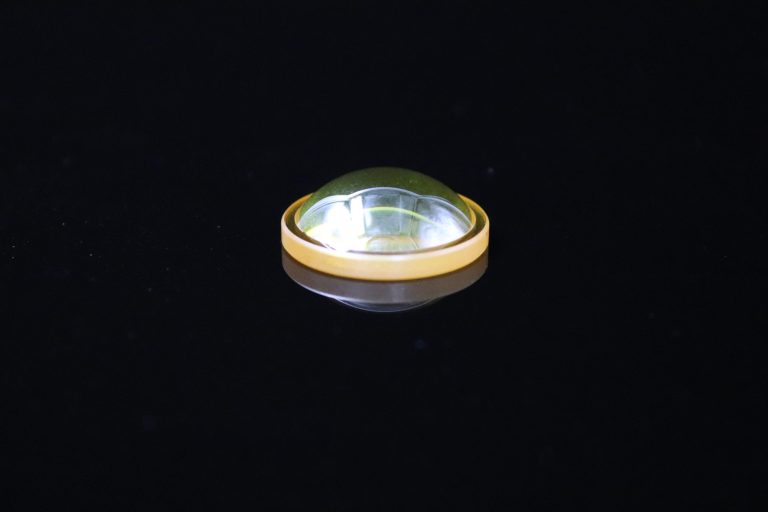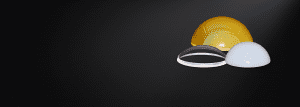Key Takeaways:
- Molded glass domes, including optical glass domes with flanges, offer superior optical clarity and durability.
- Common issues include distortion, haziness, and reduced transmission.
- Long-term challenges involve radiation degradation, thermal failure, and mechanical stresses.
- Ideal dome selection requires assessing application needs, manufacturing methods, and material choices.
Optical Dome with Flange
In the fascinating world of optical camera systems, achieving transparency is only the first step. What truly distinguishes flanged camera optical glass domes, however, is their remarkable optical invisibility. Even the most discerning eye or camera lens cannot detect their presence. In optical terms, this achievement is described as near-zero “wavefront error,” which represents a new standard of clarity and precision.
At the pinnacle of optical camera dome systems, our solution seamlessly integrates optical camera domes with proprietary flange mounting technology. Not only are these domes rugged and durable, but they also easily adapt to existing systems, promising resilience in even the harshest environments. With the right choice of flanged optical glass domes that can withstand pressures up to thousands of PSI, camera systems are being ushered into a new era of optical clarity and durability.

Common issues with flanged molded camera glass domes:
Overall Distortion | This type of distortion arises from poor glass dome design, variations in wall thickness, and material inhomogeneity. For camera systems, distortion becomes even more problematic. |
Localized Distortion & Speckle | These issues result from mold marks, bubbles, pits, scratches, and other local defects. |
Haziness | Haziness occurs due to micro-surface abrasion, devitrification, and low-quality bulk material. |
Reduced Transmission | Poor-quality material leads to signal attenuation, exacerbating reduced transmission. |
Color Shift & Chromatic Aberration | Non-neutral material color filtering and color dispersion cause color shifts and aberrations. |
Parallax Error | This error stems from overall system design, including camera positioning. |
Fresnel Reflections (Fresnel Losses) | A natural surface effect that reduces transmission and causes multiple images and signal loss. However, good system design and anti-reflective coatings can mitigate this. |
Mounting Issues: | A poorly designed flange mounting system poses risks to costly equipment. Rayotek’s flanged glass domes, with a proven track record, are securely mounted and fully sealed against hostile environments. |
Long-term reliability issues In designing a flanged molded optical glass dome:
Radiation (Light) Degradation | Prolonged exposure to sunlight and intense lighting can lead to yellowing and solarization of dome materials. |
Thermal Failure & Degradation | Plastic domes become brittle and lose strength and optical clarity when subjected to excessive heat. Glass domes, if made from the wrong material, can crack or even explode due to thermal shock. |
Mechanical Stresses | Impacts, explosions, abrasion, and other environmental hazards can compromise both optical and mechanical performance. |
Flange Seal Failure | The strength of a mounted glass dome relies on the seal to the flange. Equally critical is the reliability and durability of the seal between the housing and the glass dome. |
Addressing the quality and reliability issues mentioned above encompasses solutions ranging from straightforward, cost-effective measures to more complex and expensive ones. It’s crucial for designers to grasp the essential requirements of the application and to be aware of the constraints posed by imaging and image processing equipment. Avantier’s approach involves understanding the requirements and limitations, developing tailored solutions, optimizing technology usage, providing value to customers, and continuously improving its offerings to overcome quality and reliability issues effectively.

How to Select the Ideal Glass Dome?
When selecting the optimal glass dome for your specific application, it’s crucial to consider several key factors.
- Understand Application Requirements: Before choosing a dome, thoroughly assess your application needs to avoid unnecessary expenses. Overkill in specifications often translates to overcost. Determine the essential features required without compromising performance.
- Performance Limitations of Imaging System: Ensure that the dome does not impede the imaging system’s functionality. However, avoid going beyond what is necessary to prevent overspending. Align the dome’s specifications with the imaging system’s capabilities.
-
Manufacturing Method Impact: The method of manufacturing significantly affects both optical and mechanical performance, as well as manufacturing costs.
-
Ground and polished domes are precise but expensive. Plus, the manufacturing process can be time-consuming.
-
Molded glass domes can be press-molded or slumped.
-
Press-molded domes may exhibit mold marks and distortion, making them better-suited for non-optical applications.
-
Slump-molded glass domes offer superior surface quality compared to ground and polished domes at a lower cost.
-
-
-
Material Selection: The chosen material greatly influences optical performance and durability.
-
Plastic is inexpensive but prone to degradation and scratching over time, particularly under harsh conditions.
- Slump-molded glass domes are typically made from high-quality glass, offering durability and optical clarity.
-
- Flange Material and Sealing Process: Select appropriate flange materials by considering factors like temperature, pressure, chemical exposure, and radiation. We provide specialized expertise in sealing processes tailored to specific applications, ensuring optimal performance without unnecessary costs.
Conclusion
Choosing the appropriate glass dome for your application requires a thorough understanding of your specific requirements to effectively balance performance and cost. Factors such as manufacturing method, material selection, and flange sealing play crucial roles in ensuring optical clarity, durability, and resilience in various environments. Avantier is committed to excellence in crafting flanged camera optical glass domes. We utilize premium materials and innovative manufacturing processes to ensure unparalleled optical integrity and long-term reliability. By prioritizing these key considerations, you can confidently choose the optimal glass dome solution for your imaging system needs.
GREAT ARTICLE!
Share this article to gain insights from your connections!




